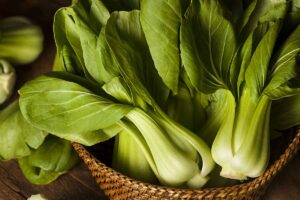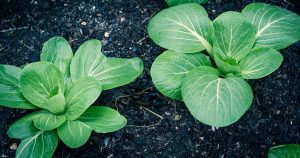You know the old saying, don’t cry over split tomatoes? Or something like that…
Tomatoes commonly split on the vine, creating an open gash. But are these still safe to use and eat?
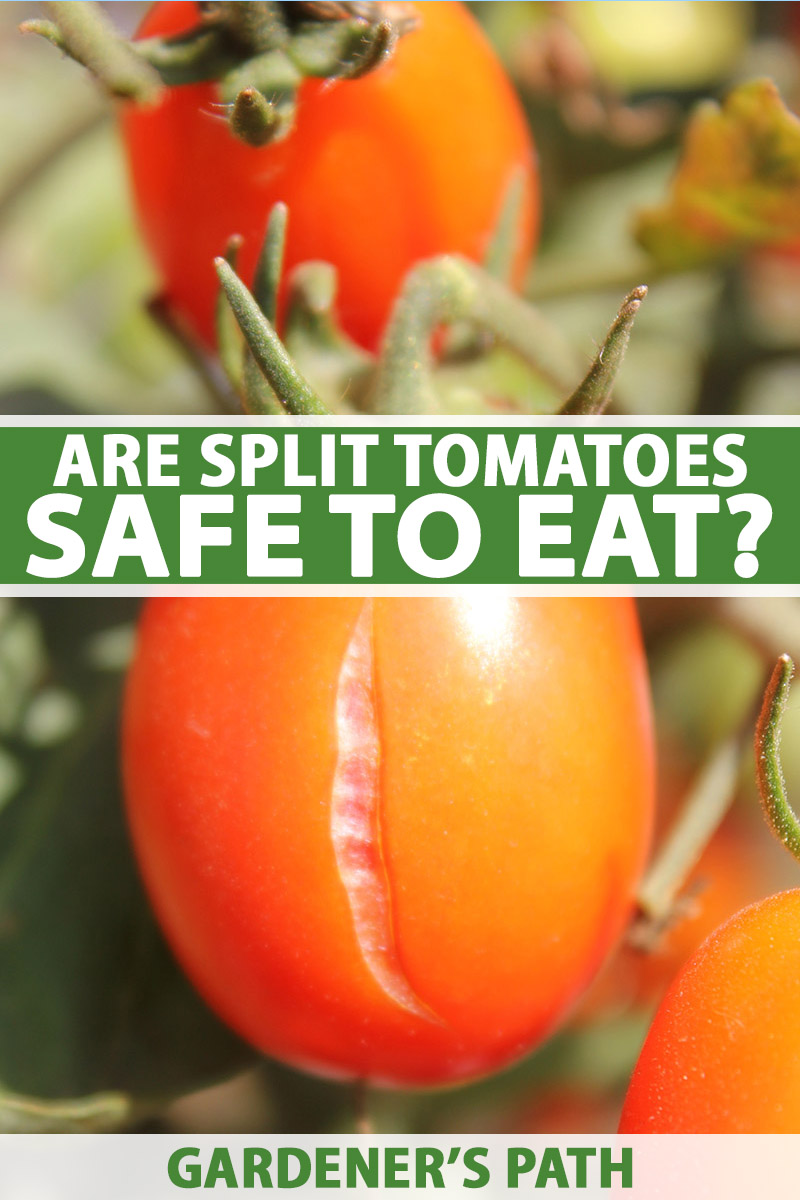
We link to vendors to help you find relevant products. If you buy from one of our links, we may earn a commission.
Let’s find out. We’ll take a look at the following:
What You’ll Learn
Why Do Tomatoes Split?
Fruits may split while they’re growing due to changes in their hydration status.
Much like when our skin is dry, when a plant lacks water, the skin of the developing fruit may crack. After a big rainstorm, when the tomatoes rehydrate and swell, that crack bursts and causes a larger crack in the fruit.
While you can’t control the weather, you can try to water as consistently as you are able to. A steady state of hydration keeps your plants happy and can prevent splits and cracks from occurring.
Water at the soil level, and keep an eye on local rates of precipitation with a rain gauge. Summer crops are sure to need some extra help in terms of irrigation during periods of hot and dry weather.
Keep in mind that container-grown plants will need more frequent watering, since the soil will dry out more quickly than it does for plants grown in the ground.
Using drip irrigation and setting a timer on your sprinkler system when you go on vacation can help to keep your plants hydrated and happy.
You can read more about watering tomato plants here, and learn more about what causes fruit to split and how to prevent cracking. (coming soon!)
Can You Eat Cracked Tomatoes?
Yes, but not always.
Confusing, right?

If a split is small and fairly superficial, affecting only the surface of the fruit, it is likely safe to eat.
How small is small enough? A bit of extra caution never hurts. You can cut around the crack after washing the fruit and just use what remains, tossing the damaged portion.
A larger gash in the side of one of those juicy orbs serves as an invitation for bacteria and fungi to set up shop, leading to rot.
If a crack is large or deep and it cuts into the flesh, tossing the fruit onto the compost pile or into the garbage is recommended.
Again, better safe than sorry where bacteria and fungi are involved.
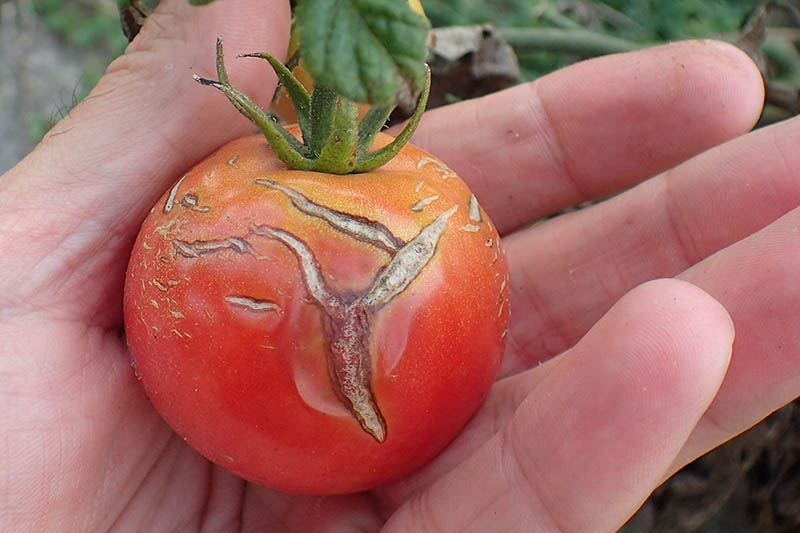
Sometimes the fruit will heal itself while it’s still on the plant, filling in the gash with firm grayish-white flesh. This firm section can be cut away after harvest.
If the inside looks bright and red when you cut it, the rest of the fruit can be saved and used.
Time is also an important element. If you notice a split, try to pick the damaged fruit as soon as you are able to.
Leaving it on the vine longer, outside in the sun, increases the risk of bacterial or fungal growth and infection.
Savoring the Split
If you are able to save a few tomatoes that only have minor splits, first off, cheers to you! The fruits of your labor have paid off, and you were able to overcome a common but frustrating gardening obstacle.
Now, what should you do with them?
Cutting away damaged pieces of the fruit may make them visually less appealing, but they’re still perfect for use in processed and cooked recipes.
In fact, cooking fresh fruit that was slightly damaged and bringing it to the boiling point can be safer than eating it fresh, as an extra fail-safe in terms of food quality.
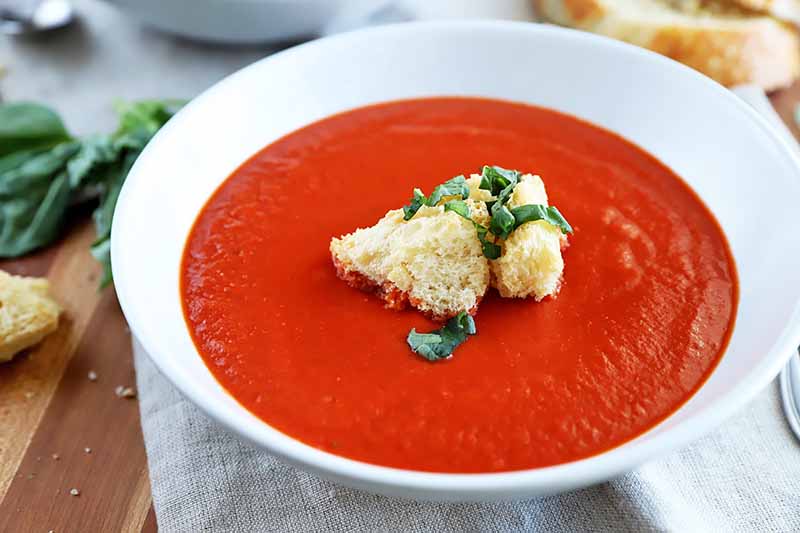
Try making your own homemade pasta sauce, cooked juice, or ketchup. You could even use your harvest in a soup or stew, like this one from our sister site, Foodal that’s easy to whip up in just 20 minutes, and flavored with fresh basil.
Jam is another tasty cooked option, but keep in mind that you should not can or put up preserves made with bruised or damaged produce.
Instead, try a quick preserve that is cooked and then stored in the refrigerator (rather than for longer periods on the shelf) like this sweet and savory tomato jam from Foodal. It’s delicious on grilled cheese sandwiches!
If you want to continue savoring the tomato goodness (split or not), take a look at these articles next:
- Top 10 Reasons to Love Tomatoes and Add More to Your Diet
- How to Grow and Care for Tomatoes in Your Garden
- How to Store Your Tomato Harvest
- How to Prevent and Treat Early Blight
Photo by Meghan Yager © Ask the Experts, LLC. ALL RIGHTS RESERVED. See our TOS for more details. Uncredited photos: Shutterstock. With additional writing and editing by Allison Sidhu.
The contents of this article have been reviewed and verified by a registered dietitian for informational purposes only. This article should not be construed as personalized or professional medical advice. Gardener’s Path and Ask the Experts, LLC assume no liability for the use or misuse of the material presented above. Always consult with a medical professional before changing your diet, or using supplements or manufactured or natural medications.


